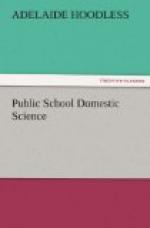Give its use?
Explain the difference in the digestion of starch and fat?
Why does starch need cooking?
To what kingdom does it belong?
Which section is of most value?
How is starch changed into sugar?
What changes food into blood?
What gives the red color to blood?
What mineral helps digestion most?
What is sugar?
What causes sugar to ferment?
What is the result?
Where is it to be found?
What are food adjuncts?
Of what value are they?
Give the names of combustible nutrients.
Give the names of incombustible nutrients.
For a substance to undergo combustion, what must it contain?
What supports combustion?
What is chemically pure water?
What causes the hardness of water?
What is gluten?
What is dextrine?
Where is it found?
In what way does dextrine differ from starch?
What is decomposition?
* * * * *
SCHEDULE OF LESSONS FOR PUBLIC SCHOOL CLASSES.
LESSON.
I. Information regarding the conduct of classes. Practice in measuring. Practice in lighting gas-burners and oven. Practice in lighting and regulating a range.
II. Fruit—Applesauce. Coddled apples. Stewed prunes.
III. Starch—Boiled rice. Potatoes, boiled and mashed.
IV. Starch—Thickening liquids with flour.
V. Starch—Practice in No. 4.
VI. Vegetables—Onions, cabbage, parsnips, etc.
VII. Eggs—Boiled eggs. Poached eggs. Toast.
VIII. Eggs and milk—Boiled and baked custard.
IX. Flour mixtures—Popovers, griddle cake.
X. Flour mixtures—Milk biscuits. Corn bread. Apple pudding.
XI. Bread—Making sponge, kneading, and setting to rise.
XII. Bread—Moulding and baking.
XIII. Fish—Boiled and baked fish. Creamed fish and sauce.
XIV. Review of theory and recipes.
XV. Meat—Roasting meat. Soup stock.
XVI. Meat—Stewed meat.
XVII. Meat—Cold meat and broiling.
XVIII. Salads.
XIX. Beans.
XX. Plain puddings.
NOTE.—After this each teacher must arrange lessons according to circumstances, age of pupils, etc., alternating cooking with lessons in care of kitchen and utensils, and lectures on sanitary matters, laundry work, setting table, and serving.
* * * * *
APPENDIX.
Outlines Nos. I and II, for class work, are contributed
by Prof.
Kinne, of Teachers’ College, Columbia University,
N.Y. City.




